Ministry of Information & Broadcasting
Building Bharat
Powering Infrastructure Through Make in India
Posted On:
01 APR 2025 8:13PM by PIB Delhi
Introduction
India’s infrastructure landscape is undergoing a monumental shift, driven by the Make in India initiative as a catalyst for growth and development. Recognising that world-class infrastructure is the backbone of economic progress, the government has launched a series of transformative projects to strengthen transportation, logistics, and urban facilities. The Bharatmala Pariyojana is enhancing road connectivity with expressways and economic corridors, while the Sagarmala Programme is revolutionising port-led development. The Smart Cities Mission is reimagining urban centres with modern amenities and digital integration, and PM Gati Shakti is streamlining multimodal connectivity for seamless movement of goods and people. These initiatives are laying the foundation for a more efficient, interconnected, and sustainable India.
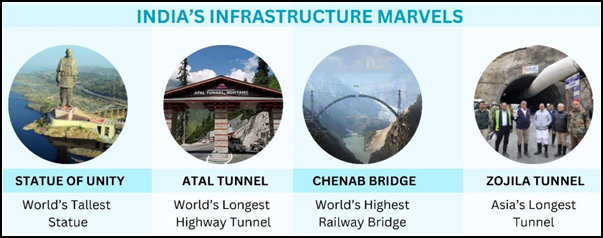
The scale of this ambition is matched by remarkable achievements that showcase India’s engineering prowess and determination. Iconic projects like the Atal Tunnel, the world’s longest highway tunnel, and the Chenab Bridge, the world’s highest railway bridge, stand as testaments to the nation’s capabilities. Meanwhile, the Statue of Unity, the world's tallest statue, and the Zojila Tunnel, Asia’s longest, highlight India’s commitment to blending innovation with resilience. The expansion of dedicated freight corridors, modern airports, and renewable energy grids further reinforces the nation’s commitment to building a resilient and future-ready economy. By aligning infrastructure growth with industrial expansion, the Make in India initiative is not just transforming physical landscapes but also unlocking new opportunities for investment, employment, and innovation.
Economic Acceleration
India’s economic acceleration is being driven by strategic infrastructure initiatives, with Make in India at the core of strengthening domestic manufacturing and industrial growth. The National Industrial Corridor Development Programme (NICDP) is creating world-class manufacturing hubs, while PM Gati Shakti enhances multimodal connectivity through data-driven planning. These initiatives are fostering seamless logistics, boosting competitiveness, and positioning India as a global economic powerhouse.
National Industrial Corridor Development Programme (NICDP)
The National Industrial Corridor Development Programme (NICDP) is a transformative initiative launched to develop world-class industrial infrastructure and promote planned urbanisation across India. By integrating smart technologies and multi-modal connectivity, the programme aims to create globally competitive manufacturing hubs while fostering economic growth and employment opportunities. These industrial corridors are being developed in collaboration with State Governments to ensure efficient planning and execution.

Key developments:
- In August 2024, the Cabinet Committee on Economic Affairs approved 12 new industrial areas across 10 states under NICDP with an investment of ₹28,602 crore.
- These industrial nodes, planned along six major corridors, will strengthen India's manufacturing ecosystem and boost its global competitiveness.
Launched in 2021, PM Gati Shakti – National Master Plan for Multimodal Connectivity strengthens the vision of Make in India by ensuring world-class infrastructure to support manufacturing and economic growth. This digital platform enhances coordination across 16 ministries, including Railways and Roadways, integrating geospatial mapping and data-driven decision-making to optimise logistics and reduce project delays. By streamlining connectivity, it bolsters industrial corridors, facilitates efficient supply chains, and attracts investments in key sectors. All projects exceeding ₹500 crore are assessed by the Network Planning Group (NPG) to ensure seamless execution.
As of March 13, 2025, 115 National Highway and road projects covering approximately 13,500 km, with an investment of ₹6.38 lakh crore, have been evaluated under the initiative, leading to more efficient infrastructure development.
Road and Maritime Connectivity
Strengthening India's road and maritime infrastructure is central to the Make in India vision, ensuring seamless connectivity for industries and boosting economic growth. Strategic initiatives like Bharatmala and Sagarmala are enhancing freight movement, improving logistics efficiency, and modernising transport networks to support India's manufacturing and trade ambitions.
Bharatmala Pariyojana is advancing India’s infrastructure by addressing critical gaps through the development of economic corridors, expressways, and connectivity roads. Aligned with the Make in India vision, the programme focuses on improving logistics efficiency, fostering industrial growth with enhanced connectivity to key hubs, and ensuring safer, more reliable transportation networks. This initiative not only boosts economic growth but also supports indigenous manufacturing and infrastructure development, making India more self-reliant in its transportation and logistics sector. Since its approval in 2017, the initiative has made significant progress:
- As on February 28, 2025, 26,425 km of projects awarded under the planned 34,800 km, with 19,826 km already constructed. The total Expenditure incurred under Bharatmala Pariyojana amounts to Rs. 4,92,562 crore.
- Till February 2025, 6,669 km of high-speed greenfield corridors awarded, of which 4,610 km have been completed.
India's National Highway network has undergone a remarkable transformation over the past decade, driven by higher budget allocations and accelerated construction. The network has expanded from 91,287 km in 2014 to 1,46,145 km in 2024, marking a 60% increase. This expansion has significantly improved connectivity, reduced travel time, and boosted economic activities across the country.
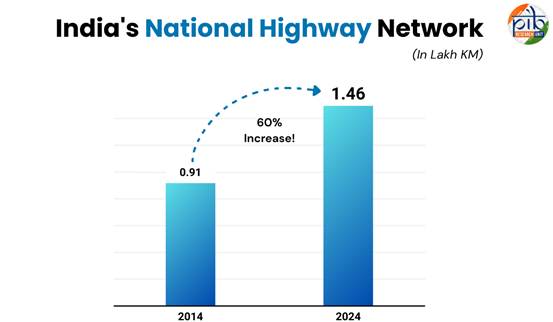
Launched in 2015, the Sagarmala Programme aligns with India’s Make in India vision by focusing on port-led development to harness the potential of the country’s extensive coastline and navigable waterways. The programme aims to enhance India’s manufacturing and export capabilities by reducing logistics costs for both domestic and international trade. It focuses on improving port infrastructure, connectivity, and the creation of coastal economic zones, which support the growth of the manufacturing sector. Additionally, initiatives like Ro-Pax ferry services, cruise terminals, and skill development for coastal communities contribute to the development of a self-reliant maritime ecosystem, further supporting India’s vision of becoming a global manufacturing hub.
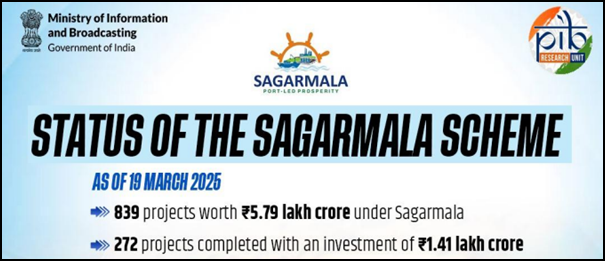
Since its approval, the initiative has made significant progress:
- As of March 19, 2025, 839 projects worth ₹5.79 lakh crores identified under Sagarmala, with 272 projects completed, investing ₹1.41 lakh crore.
- Enhanced port connectivity and coastal infrastructure to strengthen maritime trade efficiency.
Rail Infrastructure
India’s rail infrastructure has seen significant advancements, strengthening connectivity, security, and urban mobility. Flagship initiatives such as Vande Bharat trains and metro rail expansion are enhancing passenger experience, modernising transit hubs, and ensuring seamless travel. With a strong push under Make in India vision, the railway network’s expansion, underscores the commitment to inclusive growth and efficient transportation.
Launched in 2019, Vande Bharat trains exemplify the Make in India vision, showcasing the nation's engineering capabilities in railway modernisation. As the first-ever indigenously designed and manufactured semi-high-speed trains, they feature modern coaches, advanced safety features, and enhanced passenger amenities. Equipped with automatic plug doors, ergonomic reclining seats, and individual mobile charging sockets, these trains ensure a premium travel experience. Operating on medium and short-distance routes, they improve connectivity while significantly reducing travel time.
Indian Railways is also set to transform long-distance travel with the Vande Bharat Sleeper Train Set. The first 16-car set, manufactured by Integral Coach Factory, Chennai, completed successful trials on the Mumbai-Ahmedabad route on 15th January 2025, covering 540 kilometers. Following its completion on 17th December 2024, the train was tested in the Kota division at speeds of 180 km per hour, ensuring comfort and high performance for long-distance journeys.
Since its introduction, the initiative has made significant progress:
- 136 Vande Bharat trains are running across India as of March 18, 2025, offering world-class travel experiences.
- Varied operational schedules include 122 services running six days a week, 2 services four days a week, 8 tri-weekly, and 4 weekly services.
Amrit Bharat Station Scheme
The Amrit Bharat Station Scheme is a long-term initiative to modernise railway stations across India, enhancing passenger amenities, multimodal connectivity, and overall infrastructure. With a focus on continuous development, the scheme aims to transform stations into modern transit hubs. As of March 12, 2025, 1,337 stations have been identified for upgradation, ensuring improved accessibility, better facilities, and a seamless travel experience.
India's Metro Rail system has been instrumental in transforming urban transportation, offering a fast, reliable, and eco-friendly alternative to traditional commuting methods. The network's expansion gained momentum with increased government focus, ensuring seamless connectivity in major cities. Since 2014, metro systems have rapidly grown, alleviating congestion and enhancing urban mobility. Notably, BEML Limited, a ‘Schedule A’ Company under the Ministry of Defence, has played a key role in manufacturing metro coaches. As of May 2024, BEML has supplied over 2,000 metro coaches to various metro corporations, including those in Delhi, Jaipur, Kolkata, Bangalore, and Mumbai.
In addition to metro networks, India has also made significant strides with the introduction of the Regional Rapid Transit System (RRTS). The Namo Bharat trains operating on the Delhi-Meerut RRTS corridor are a prime example of India's commitment to modernising mass transit systems, offering faster and more efficient travel across regions.
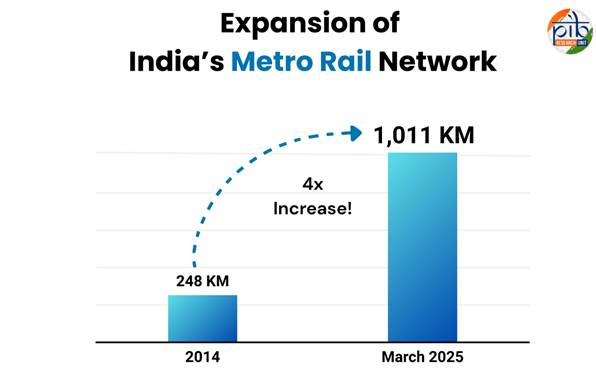
Since its launch, the initiative has made significant progress:
- The metro network has expanded from 248 km in 2014 to 1,011 km by March 2025, covering over 20 cities.
- India's first Namo Bharat train, operating on the Delhi-Meerut RRTS corridor, enhances regional connectivity with state-of-the-art infrastructure.
Civil Aviation
India's aviation sector has witnessed unprecedented growth, driven by rising demand and proactive government policies aimed at strengthening air connectivity. This rapid expansion has positioned India as the third-largest domestic aviation market globally. The government's focus on regional connectivity and infrastructure development has ensured improved accessibility, fostering economic growth and mobility across the country.
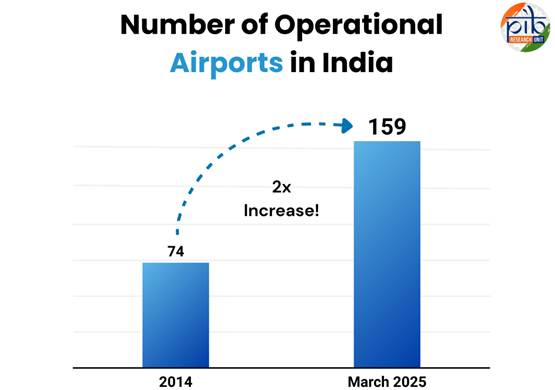
Since its push for expansion, the sector has achieved notable milestones:
- The number of operational airports increased from 74 in 2014 to 159 by March 2025, enhancing regional connectivity.
- On November 17, 2024, domestic air passenger traffic surpassed 5 lakh in a single day, setting a new record.
- The number of Flying Training Organisations (FTOs) grew from 29 in June 2016 to 38 with 57 bases by December 2024, strengthening pilot training capacity.
Conclusion
India’s infrastructure and construction sectors have been pivotal in driving the Make in India initiative, creating the backbone for industrial growth and economic expansion. Landmark projects in road, rail, maritime, aviation, and urban development have not only improved connectivity and logistics but also enhanced the quality of life across rural and urban areas. The expansion of national highways, metro networks, and modern rail services, alongside transformative schemes like PM Gati Shakti and Smart Cities Mission, underscores the country’s commitment to sustainable growth. With continued investments in infrastructure and technological innovation, India is poised to unlock new opportunities for industries, boost employment, and accelerate economic progress, solidifying its position as a global manufacturing and logistics hub.
Make in India (Infrastructure)/ Explainer/ 06
References:
Kinldy find the pdf file
****
Santosh Kumar/ Ritu Kataria/ Saurabh Kalia
(Release ID: 2117488)
Visitor Counter : 728